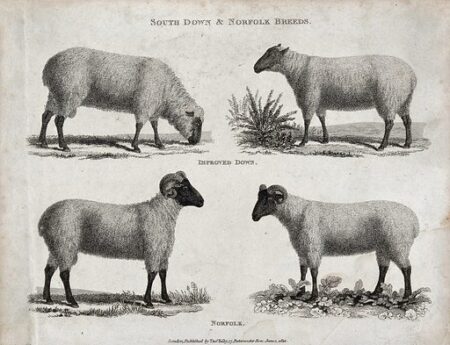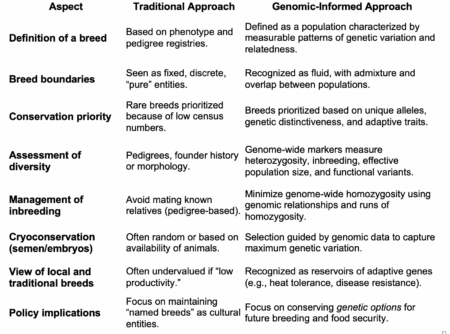- The US needs better maize.
- German genebank looks for the best potatoes.
- Vietnam looks for better rice in IRRI’s genebank.
- New Zealand markets an endophyte for better grass performance.
- Some Timor-Leste fish are better than others.
- The Himalayas have a better pea. Of some kind.
- How’s that for subversive cataloguing?
A breed is a breed is a breed?
I feel maybe yesterday’s Nibble on the definition of a “breed” may have been a bit too laconic, even for me. So let me give a bit more context.

The link was to a YouTube playlist, which was described thus (link added):
The presentations in this playlist are from the webinar on “Genomic assessment of genetic variation and the future of the breed concept”, originally held on 12.12.2024 under the umbrella of the Food and Agricultural Organization (FAO). This represents the culmination of collaborative work by a diverse group of experts from institutions from all around the world to prepare materials for a sub-chapter in the upcoming 3rd Report on the State of the World’s Animal Genetic Resources for Food and Agriculture.
It amounts to over an hour of talks, but if I had to summarize the point the playlist is making, it is that genomics is redefining a breed as a fluid, porous, genotypically-characterized population rather than a fixed, pedigree-based, phenotypic entity. Thus, it is shifting livestock conservation from saving labels (“Breed A”) to preserving genetic options.
Here’s a handy table I came up with to describe the change:
Interesting to juxtapose this to the post a few days ago on how to value and use Indigenous knowledge to solve today’s problems. Would Indigenous livestock keepers necessarily care about those genetic options more than their traditional breed?
It would be great to hear from people engaged in livestock conservation on this. It’s unfortunately not a community I interact with much.
Brainfood: Core collections of…durum, deulkkae, barnyard millet, durian, sesame, flax, Fendler’s horsenettle, jute mallow, barley
- Creation of a core set of durum wheat accessions based on agro-morphological traits with maximum diversity and lower redundancy. From 710 to 13 accessions (2%!) using 32 morphological traits, thanks to Power Core.
- Construction of a core collection of Perilla frutescens (L.) Britton Germplasm in the South Korean gene bank using agro-morphological traits. From 1227 to 235 accessions (19%) using 17 morphological traits, thanks to a bunch of different methods.
- Comprehensive Phenotyping of 1,807 Indian Barnyard Millet (Echinochloa frumentacea Link) Accessions from Indian National Genebank: Unlocking Diversity for Core Set Development. From 1,807 to 271 accessions (15%) using 23 quantitative traits, thanks to Core Hunter 3.
- Genomic resequencing reveals genetic diversity, population structure, and core collection of durian germplasm. From 114 to 26 accessions (23%) using 39 million high-quality SNPs across the genome.
- Development of a composite core collection from 5,856 sesame accessions being conserved in the Indian National Genebank. From 5,856 to 1,768 accessions (30%) using SNPs and phenotypic data.
- Optimizing core collections for genetic studies: a worldwide flax germplasm case study. From 1,593 to 350 accessions (22%) using phenotypic and genotypic data, times 200, thanks to CoreCollection, corehunter III, TrainSel, and more.
- An Optimized Core Sample of the Wild Potato Solanum fendleri in the USA. From 269 accessions, to 38 plants, to 1 accession (0.4%!). Beat that!
- Countrywide Corchorus olitorius L. core collection shows an adaptive potential for future climate in Benin. From 305 to 54 accessions (18%) using 1,114 high-quality SNPs, thanks to ShinyCore. Some indication of usefulness.
- Multi-environmental evaluation of barley core collection against spot blotch for genetic variability and identification of promising genotypes exhibiting resistance. From a core collection of 678 accessions to 2 genotypes that might actually be useful to breeders. Finally!
Brainfood: Agroecology, Afghan wheat, CWR microbes, Chocolate microbes, Liberica coffee, Wild apples, USDA cotton collection, Parmesan cattle, Sweetpotato genome, Vertical tomatoes
- Embracing new practices in plant breeding for agroecological transition: A diversity-driven research agenda. Plant breeding for agroecology will need access to locally-adapted plant diversity, sure, but also the involvement of a diversity of stakeholders and the use of a diversity of co-design strategies.
- Conservation and Utilization of Wheat Genetic Resources in Afghanistan Expanded with the Homecoming Wheat Landraces Collected Half a Century Ago. The above could also be said of wheat breeding in Afghanistan. Fingers crossed.
- Blueprints for sustainable plant production through the utilization of crop wild relatives and their microbiomes. Oh, wait, breeders (agroecological and otherwise) will also need the diversity of microbiomes associated with crop wild relatives.
- A defined microbial community reproduces attributes of fine flavour chocolate fermentation. Oh, wait, we will also need the diversity of the microbes involved in fermentation, at some point.
- Genomic data define species delimitation in Liberica coffee with implications for crop development and conservation. It might help if we knew how many species made up a crop in the first place. In the case of Liberica coffee, it turns out to be 3. No word on the microbiomes involved.
- Assessment of genetic diversity and population structure of Malus sieversii and Malus niedzwetzkyana from Kazakhstan using high-throughput genotyping. It would also help to know where interesting diversity was concentrated within crop wild relatives. In apples, it’s not necessarily the ancestor.
- The National Plant Germplasm System cotton collection—a review of germplasm resources, phenotypic characterization, and genomic variation. Lots of morphological characterization and agronomic evaluation, not so much molecular data, but increasing. No word on the microbes.
- Establishing a genomic-driven conservation of a cattle genetic resource: the case of the Parmigiano-Reggiano cheese iconic breed. In contrast, these guys have genotyped practically a whole breed. But yeah, no microbes.
- Phased chromosome-level assembly provides insight into the genome architecture of hexaploid sweetpotato. The contributions of different wild relatives to the sweetpotato genome are to be found intertwined along chromosomes rather than restricted to subgenomes. Unclear what that will mean to agroecologial breeders.
- Harnessing Green Revolution genes to optimize tomato production efficiency for vertical farming. Agroecological breeders unavailable for comment.
Tuber or not tuber
A paper in Cell has really caught the imagination of the media in the past few days. You wouldn’t necessarily be able to guess why from its title, though: “Ancient hybridization underlies tuberization and radiation of the potato lineage.” The reason for all the interest, I guess, is that the hybridization in question was between a potato ancestor with no tubers and a plant that was closer to a tomato. Yes, two genes from distant lineages, neither tuber-forming, combined by chance some 9 million years ago to produce the progenitor of all tuber-bearing potatoes, which then diversified as the Andes were uplifted and themselves diversified. Definitely worth the hoopla.
Jeremy also includes the paper in his latest newsletter.
